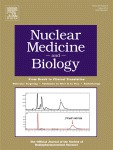Biological studies in animal models using [99mTc](CO)3 recombinant annexin V as diagnostic agent of apoptotic processes
Dublin Core
Título
Biological studies in animal models using [99mTc](CO)3 recombinant annexin V as diagnostic agent of apoptotic processes
Tema
RADIOQUIMICA
TECNECIO
BIBLIOGRAFIA NACIONAL QUIMICA
2011
Abstract
Introduction: There are many diseases associated with variations in the expression of apoptosis such as organ rejection after transplantation, myocardial ischemia or infarct and neurodegenerative diseases. For this reason, the early visualization of this process is relevant to set fast and effective therapeutic strategies. Methods: The precursor was prepared according to the procedure reported by R. Alberto, R. Schibli, P. Schubiger, U. Abram, and T. Kaden [Reactions with the technetium and rhenium carbonyl complexes (NEt4)[MX3(CO)3]. Synthesis and structure of Tc(CN-But)3(CO)3](NO3) and (Net4)[Tc2(μ-SCH2CH2OH)3(CO)3], Polyhedron 1996;15: 1079–89]. Recombinant annexin V was incubated with [99mTc](H2O)3(CO)3 + solution, previously neutralized with buffer. Biodistribution studies were performed in 8-week-old female Wistar rats. Animals were housed and treated in compliance with institutional guidelines related to animal experimentation. Work protocol was previously approved by the Animal Ethics Committee of the university. Two groups of rats were defined. One was used as control and the other group was previously injected with 150 mg/kg ip of cyclophosphamide to induce apoptosis. Results: The synthesis of carbonyl precursor achieved yields higher than 90%, and the radiolabeled protein was obtained with 92% of radiochemical purity and high stability in vitro. An important uptake in apoptotic tissues was confirmed by biodistributions, scintigraphic images and histological studies. Conclusions: Biodistribution studies revealed hepatobiliary elimination, high stability in vivo and important uptake in the reticuloendothelial system. In the pathologic model, higher uptake values correspond to the liver, spleen, lungs and femur. Histological studies confirmed the development of apoptosis at 8 and 24 h postinduction in the spleen and lymphocyte bulks in the peribronchial area. Scintigraphic images confirmed high uptake both the spleen and the lungs.
Autor
Martínez, Elena
Reyes, Ana L.
Paolino, Andrea
Vital, Marcelo
Pacheco, José Pedro
Fuente
Nuclear Medicine and Biology v. 38, no. 2, 2011. -- p. 279-285
Editor
Elsevier
Fecha
2011
Formato
PDF
Idioma
Inglés
Tipo
Artículo
Identificador
doi:10.1016/j.nucmedbio.2010.08.007
- Fecha de agregación
- October 7, 2013
- Colección
- Bibliografía Nacional Química
- Tipo de Elemento
- Document
- Etiquetas
- Radioquímica, Tecnecio
- Citación
- Terán, Mariella A., “Biological studies in animal models using [99mTc](CO)3 recombinant annexin V as diagnostic agent of apoptotic processes,” RIQUIM - Repositorio Institucional de la Facultad de Química - UdelaR, accessed July 26, 2024, https://riquim.fq.edu.uy/items/show/1031.
- Archivos

